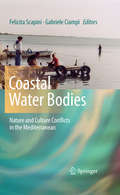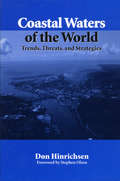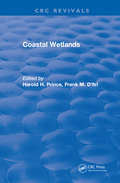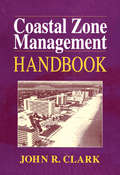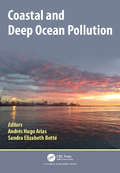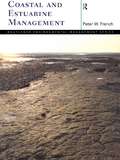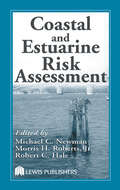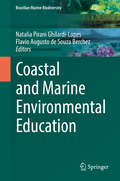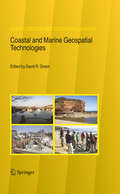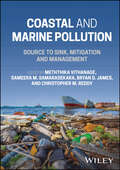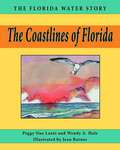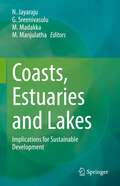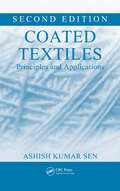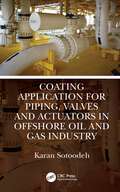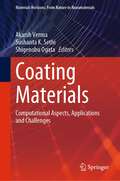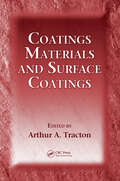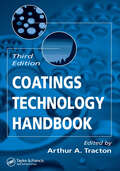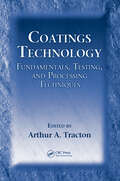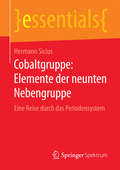- Table View
- List View
Coastal Water Bodies: Nature and Culture Conflicts in the Mediterranean
by Felicita Scapini Gabriele CiampiAddressing the links between science and the real world with a sound scientific baseline, Coastal Water Bodies targets researchers of various disciplines whose interest lies in the integrated sustainable management of coastal water bodies. The main topic of this book is not the ecology according to its accepted meaning, but rather the 'places and people' concerned - the coastal zones of the Mediterranean that are rich in ecological value and the local people who survive thanks to these environmental resources. Integration is the joint consideration of different aspects of water uses and values, and new ways of understanding and managing conflicts around water use are needed if people are to benefit from integration. Sustainability of the ecological and socioeconomic environments requires a climate in which conflicts, if they need to exist, are properly managed in a non-destructive manner.
Coastal Waters of the World: Trends, Threats, and Strategies
by Don Hinrichsen Stephen OlsenNearly 60 percent of the world's population lives and works within 100 miles of a coast, and even those who don't are connected to the world's oceans through an intricate drainage of rivers and streams. Ultimately the whole of humankind is coastal. Coastal Waters of the World is a comprehensive reference source on the state of the world's coastal areas. It focuses on the tremendous pressures facing coastal areas and the management systems and strategies needed to cope with them. Don Hinrichsen explores the origins and implications of three related issues: the overwhelming threats to our coastal resources and seas from population and pollution; the destruction of critical resources through unsustainable economic activity; and the inability of governments to craft and implement rational coastal management plans. Introductory chapters present a concise summary of our coastal problems, including coastal habitat degradation and the fisheries crisis, along with a discussion of better management options. Three case studies of successful coastal governance focus on some of the problems and bring to life potential solutions. Following that are regional profiles that provide detailed information on the main population, resource, and management challenges facing each of the world's thirteen major coastal waters and seas. The book ends with a realistic and practical agenda for action that can be implemented immediately. Safeguarding these complex, interlinked ecosystems is humanity's most challenging management job. Coastal Waters of the World will help raise our awareness of coastal area concerns and provide a constructive contribution to the ongoing debate over how to manage these ever-changing areas, both for ourselves and for future generations. It will serve as a valuable reference tool and an up-to-date resource for policymakers, management specialists, and students interested in sustainable coastal governance.
Coastal Wetlands
by Harold H. PrinceThis book represents the proceedings of the firstGreat Lakes Costal Wetlands Colloquium (November 5-7, 1984; East Lansing, Michigan). The theme wasNatural and Manipulated Water Levels in Great Lakes Wetlands. This material constitutes both Great Lakes wetlands and the state of understanding about them. It is intended to provide fisheries and wildlife biologists, ecologists, aquatic resource managers and planners and environmental scientists information about the coastal wetlands in regard to eight priority areas. The colloquium and publication of the proceedings were cosponsored by Sea Grant Program and Environment Canada.
Coastal Wetlands of the World Geology, Ecology, Distribution and Applications
by David B. Scott Jennifer Frail-Gauthier Petra J. Mudie David B. Scott Jennifer Frail-GauthierSalt marshes and mangrove forests, the intertidal wetlands of the world's coastlines, provide key ecological services to all areas of the globe. This cutting-edge, richly illustrated book introduces the essential elements of coastal wetlands and their applications. The book opens by introducing coastal oceanography, the physical features of wetlands, their ecology, and human impacts upon them, giving all students the necessary background for wetlands studies. It then presents detailed case studies from around the world with extensive illustrations, supplying a wider, global-scale picture of wetlands geomorphology and biodiversity. The final chapters discuss some unique applications of coastal wetlands, including geological monitoring, uses in biotechnology and agriculture, and various experimental mesocosms. This is ideal as supplementary reading to support students on a wide range of earth and life science courses, from environmental science, ecology and palaeoecology to geomorphology and geography. It will also be a valuable interdisciplinary reference for researchers.
Coastal World Heritage Sites (Coastal Research Library #28)
by Vanda Claudino-SalesThis book presents the natural, environmental and scenic richness of the world’s coastal and marine areas classified by UNESCO as “Natural World Heritage Sites”. Representing well-preserved areas of exceptional significance to the planet and to humankind, they include a total of 49 marine sites, formed by reefs, atolls and gulfs, and 35 coastal sites in all oceans and all continents with exception of Antarctica. They are being protected and preserved from most degrading uses for future generations as an important legacy from the past. Exploring their richness, this book analyzes and explains these sites in a clear, understandable, scientific way, and is of interest to all who work in or care about the geosciences, environmental sciences and biosciences.
Coastal Zone Management Handbook
by John R. ClarkCoastal Zone Management Handbook comprises the first complete manual on coastal resource planning and management technology. Written by an international consultant, this handbook reflects a global perspective on the natural resources, sensitivities, economics, development, productivity, and diversity of coastal zones. The emphasis is on tropical and subtropical coastal ecosystems, but the information is widely applicable. In addition to its comprehensive coverage of general concepts related to coastal regions, the book describes the strategic basis for coastal management, provides a set of working tools for management and planning activities, and presents case histories of management projects around the globe. Extensive references are provided for each management analysis, practice, technique, and solution. Coastal Zone Management Handbook is made up of four sections:
Coastal and Deep Ocean Pollution
by Andrés Hugo Arias; Sandra Elizabeth BottéDuring the recent decades, social, political and academic endeavours have been made to improve environmental quality and reduce pollution. In particular, the ocean, sea and coastal areas show varying degrees of impact from the multiple human activities carried out in the terrestrial as well as in the aquatic environment. Ecology is a science which studies the relationship between organisms and the surrounding environment and in the modern era, the marine world is getting increasing attention. For centuries it has been the final reservoir of human garbage; later it became an oil farm with a concomitant increase of coastal population growth and unplanned growth of the fishing industry and the increasing use of sea routes for cargo transport and recreational uses (cruises). All this led to rising contamination with negative effects on biota and even human health. It is then imperative to know the current situation of the world's oceans: that is the main purpose of this book, to document at a glance the latest research in the field of ocean pollution.
Coastal and Estuarine Management (Routledge Environmental Management)
by Peter FrenchThe coast cannot be left to nature to determine its fate. Wealth, property, economic interests, recreation, tourism and wildlife are all threatened. Coasts are an administrative battle ground and one of the most important and widely examined topics in environmental management.Coastal and Estuarine Management examines the issues surrounding the human use and abuse of estuarine and coastal environments. Emphasising the importance and significance of this natural resource, the uses and conflicts which occur and the results of human activity, this book explains the ways in which conservation and management policies and practices can protect this productive and diverse ecosystem.Examples and real-life case studies illustrate the effect of human intervention, both from an historic and contemporary perspective. Exposing the environmental consequences of estuarine pollution, Peter French highlights the need for management strategies to promote a sustainable development ethic for estuaries.
Coastal and Estuarine Risk Assessment (Environmental and Ecological Risk Assessment)
by Michael C. Newman Morris H. Roberts Robert C. HaleWritten by experts in the field, Coastal and Estuarine Risk Assessment explores the science of exposure, effect, and risk. This is the first book to address the application of the current risk assessment paradigm from the National Research Council to coastal and estuarine environments. It provides the necessary applications for modifying the paradigm and shows how to use it to perform an effective assessment. Topics include: fate and bioavailability of organic compounds, emerging contaminants, effects of populations, effects to marine mammals, risk from multiple stressors, European approaches to risk assessment, effects of land use, and more.
Coastal and Marine Environmental Education (Brazilian Marine Biodiversity)
by Natalia Pirani Ghilardi-Lopes Flavio Augusto BerchezThis book provides a broad overview of how the promotion of ocean and coastal literacy is being planned, applied and evaluated in Brazil, a country of continental dimensions with a great diversity of cultural, educational and social realities. It discusses a range of target groups, from children to adults; formal and informal strategies; and various promoting players, such as groups/institutions. Researchers representing Brazilian academic institutions and NGOs share their environmental education (EE) experiences in Brazil and describe the main concerns regarding the marine and coastal environments as well as how they are addressing these concerns in their EE projects. This book is of interest to anyone who is looking for ways of designing and implementing EE activities with a robust theoretical background in different socio-cultural scenarios.
Coastal and Marine Geospatial Technologies (Coastal Systems and Continental Margins #13)
by D. R. GreenThis international collection of papers represents a selected and up-to-date overview of some of the main areas of research into the application of the geospatial technologies, including geographical information systems (GIS), remote sensing, digital mapping, global positioning systems (GPS), databases, Internet technology, and mobile field-data collection and mapping, to coastal and marine environments around the World. Aimed at the researcher, editor, practitioner and student, this volume seeks to expand the available literature in a rapidly expanding and evolving area, namely the coastal and marine environment. The book comes at a time when there is growing concern about global warming, climate change, and sea level rise, all of which will have an impact upon coastal areas. These geospatial technologies offer the possibility to gather unique environmental data to study the coast, to process the data into information, to visualise data and landscapes, to gather data in the field, and to involve stakeholders in coastal management amongst other things. Considerable potential now exists to raise awareness, to educate and to embrace these technologies as one way to promote greater knowledge and understanding of our marine and coastal environments.
Coastal and Marine Pollution: Source to Sink, Mitigation and Management
by Meththika Vithanage Sameera M. Samarasekara Bryan D. James Christopher M. ReddyA multi-faceted analysis of how to preserve the long-term health of the world’s largest ecosystem In Coastal and Marine Pollution: Source to Sink, Mitigation and Management, a team of distinguished researchers delivers a comprehensive overview of the factors and stakeholders impacting — and impacted by — coastal and marine pollution. The book offers broad and up-to-date coverage of the topic, serving as a valuable reference for professionals and researchers working in the field. The authors integrate and compare the two main sources of marine and coastal pollution: chronic, long-term, low-level pollution as well as occasional, accidental, disaster-related pollution. They bridge the gap between theory and real-world action, offering best practices for monitoring and preventing pollution, as well as efficient governance and disaster management strategies. Readers will find: A thorough overview of the global state of coastal and marine pollutionComprehensive explorations of different types of pollution, including their sources, distribution, and impacts on the biophysical environmentPractical discussions of pollution monitoring methods, including ecotoxicological approaches and proven strategies for managing coastal and marine pollutionA critical assessment of policy and governance issues, including public awareness and disaster response strategies Perfect for researchers and professionals in the fields of marine biology, ecology, and environmental protection, Coastal and Marine Pollution will also benefit professionals working in the shipping, fishing, deep-sea mining and drilling industries, as well as those affiliated with governmental and non-governmental organizations.
Coastlines of Florida (Florida Water Story)
by Peggy Sias Lantz Wendy A HaleThis charmingly illustrated booklet explores Florida's 1,100-mile-long coastline and introduces children to the plants and animals that live along the shore. It was originally published as part of The Florida Water Story in 1998. This is one of a four part series that includes the Oceans, the Coral Reefs and the Wetlands of Florida.Next in series > >See all of the books in this series
Coasts, Estuaries and Lakes: Implications for Sustainable Development
by N. Jayaraju G. Sreenivasulu M. Madakka M. ManjulathaThis volume discusses geological, biological and sustainability aspects of coastal, estuary and lake environments. It offers a comprehensive understanding of biotic, physico-chemical, sedimentological and socio-environmental factors associated with the sustainable development of these environments in areas vulnerable to climate change and other anthropogenic activities. The book is divided into several main sections, covering the geological and biological processes and dynamics of these environments, water quality and hydrological modeling, sediment characteristics, bio-indicators and ecological analysis, climate change impacts, geospatial applications, and sustainable development practices and scenarios. The book aims to be a useful resource for academics, scientists, coastal and marine practitioners, meteorologists, environmental consultants and computing experts working in the areas of earth and ocean sciences.
Coated Textiles: Principles and Applications, Second Edition
by Ashish Kumar SenInitially written to pull together scattered literature in polymer science and textile technology, the first edition of Coated Textiles: Principles and Applications became a gold standard resource in this field. Completely revised and updated, this second edition reflects not only the latest developments in the field, but also explores futur
Coating Application for Piping, Valves and Actuators in Offshore Oil and Gas Industry
by Karan SotoodehThis book looks at the applications of coating in piping, valves and actuators in the offshore oil and gas industry. Providing a key guide for professionals and students alike, it highlights specific coating standards within the industry, including ISO, NORSOK, SSPC and NACE. In the corrosive environment of a seawater setting, coatings to protect pipes, valves and actuators are essential. This book provides both the theory behind these coatings and practical applications, including case studies from multinational companies. It covers different offshore zones and their corrosivity level alongside the different types of external corrosion, such as stress cracking and hydrogen-induced stress cracking. The key coatings discussed are zinc-rich coatings, thermal spray zinc or aluminum, phenolic epoxy and passive fire protection, with a review of their defects and potential failures. The book also details the role of coating inspectors and explains how to diagnose faults. Case studies from companies such as Aker Solutions, Baker Hughes, Equinor and British Petroleum illustrate the wide range of industrial applications of coating technologies. This book is of interest to engineers and students in materials, coating, mechanical, piping or petroleum engineering.
Coating Materials: Computational Aspects, Applications and Challenges (Materials Horizons: From Nature to Nanomaterials)
by Akarsh Verma Shigenobu Ogata Sushanta K. SethiThis book comprehensively reviews assorted types of coatings, their applications, and various strategies employed by several scientists and researchers to fabricate them. Exclusively, the recent progress in computational strategies that are helpful to optimize the best suitable coating formulation before one goes for the real-time fabrication has been discussed in detail. And this book is also intended to shed light on the computational modeling techniques that are used in the characterization of various coating materials. It covers mechanisms, salient features, formulations, important aspects, and case studies of coatings utilized for various applications. The latest research in this area as well as possible avenues of future research is also highlighted to encourage the researchers.
Coating Substrates and Textiles: A Practical Guide to Coating and Laminating Technologies
by Andreas GiessmannThis book provides knowledge on the finishing of substrates with a functionalising coating, emphasizing on technical textiles. The spectrum of topics covers different substrates and coating materials, process engineering and equipment components as well as complex machinery. The reader is presented with an overview of the technical capabilities of substrate coating, enabling the practitioner to design and implement new products. Furthermore the author goes into detail on various air pollution control procedures and economic issues of asset valuation.
Coatings Materials and Surface Coatings
by Arthur A. TractonDrawing from the third edition of The Coatings Technology Handbook, this text provides a detailed analysis of the raw materials used in the coatings, adhesives, paints, and inks industries. Coatings Materials and Surface Coatings contains chapters covering the latest polymers, carbon resins, and high-temperature materials used for coatings, adhesiv
Coatings Technology Handbook
by Arthur A. TractonServing as an all-in-one guide to the entire field of coatings technology, this encyclopedic reference covers a diverse range of topics-including basic concepts, coating types, materials, processes, testing and applications-summarizing both the latest developments and standard coatings methods. Take advantage of the insights and experience of over
Coatings Technology: Fundamentals, Testing, and Processing Techniques
by Arthur A. TractonDrawn from the third edition of The Coatings Technology Handbook, this book focuses entirely on testing, experimental design, and strategies for selecting processing techniques in the coatings, adhesives, paints, and inks industries. Coatings Technology: Fundamentals, Testing, and Processing Techniques contains the latest coating and processing met
Cobalt Blues: The Story of Leonard Grimmett, the Man Behind the First Cobalt-60 Unit in the United States
by Peter R. AlmondFor the last half of the 20th century cobalt-60 units were the mainstay of radiation treatments for cancer. This book describes the development of the first cobalt -60 unit in the United States and the man behind it, Leonard Grimmett. Conceptually conceived before World War II it only became possible because of the development of nuclear reactors during the war. The initial idea was to replace the radium in the contemporary units of the time with cobalt-60, but with the realization that the reactors could produce much more cobalt-60 than originally thought the design of the cobalt-60 unit was drastically changed to take advantage that the application of the inverse square law to cancer radiation treatments would make. Although Grimmett conceived of and published his ideas first, the Canadians built the first units because of the capability of their reactor to produce more suitable cobalt-60 sources. The story tells how Grimmett and the other people involved came together at the time that the U S Atomic Energy Agency was pushing the use of radioactivity in medicine. But Grimmett died suddenly before his unit could be built and very little information about him was known until recently when various documents have come to light, allowing the full story to be told.
Cobaltgruppe: Eine Reise durch das Periodensystem (essentials)
by Hermann SiciusHermann Sicius stellt ausf#65533;hrlich die Elemente der neunten Nebengruppe (Cobalt, Rhodium, Iridium und Meitnerium) vor, deren physikalische und chemische Eigenschaften relativ #65533;hnlich sind. Cobalt wurde 1735 entdeckt, Rhodium und Iridium Anfang des 19. Jahrhunderts. Auch beim Elementenpaar Rhodium und Iridium ist noch die Auswirkung der Lanthanoidenkontraktion zu beobachten. Die jeweiligen physikalischen Eigenschaften dieser zwei Elemente unterscheiden sich jedoch schon merklich, nicht aber die chemischen. Die Eigenschaften des Cobalts dagegen weichen von denen der zwei ,,edlen" Platinmetalle Rhodium und Iridium deutlich ab, so zeigt Cobalt ein negatives Normalpotential sowie niedrigere Dichten, Schmelz- und Siedepunkte. Bei Cobalt ist aber die Oxidationsstufe +2 die stabilste, bei Rhodium +3 und bei Iridium +4. K#65533;rzlich gelang jedoch die Erzeugung von Iridium-VIII- und IX-Verbindungen. 1982 konnten die ersten Atome des Meitneriums erzeugt werden.
Coccidiosis in Livestock, Poultry, Companion Animals, and Humans
by J. P. DubeyCoccidiosis is one of the most important diseases of livestock, particularly poultry, with billions of dollars spent on prevention worldwide. The disease is so important and pervasive that until recently, all poultry feed was medicated with coccidiostats, mainly antibiotics. With the rapid development of drug resistance, the search is on for alternative methods of control of coccidiosis in poultry. With chapters authored by internationally renowned scientists, this book covers coccidiosis in all major livestock species, including cattle, sheep, and goats. Special emphasis is given to poultry coccidiosis given the significant economic impact, and another chapter looks at intestinal coccidiosis in humans, including Cyclospora. Chapters discuss techniques, molecular biology, host-pathogen immunobiology and immunoprophylaxis, genetics and genomics, biology, and chemotherapy. Despite an explosion of research in the last 40 years, there has been no new book published discussing conventional coccidiosis for more than 25 years. This comprehensive review therefore answers an urgent need for a book dealing exclusively with conventional coccidia (Cystoisospora, Cyclospora). It provides concise, authoritative, up-to-date information on coccidiosis, with particular attention given to research in the last 28 years. This book is essential reading for any practitioner or researcher involved in livestock production, including biologists, veterinarians, parasitologists, and researchers from government, academia, and industry.
